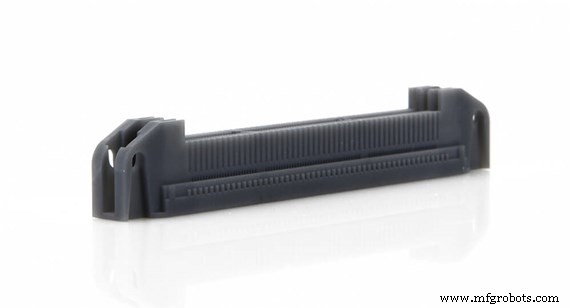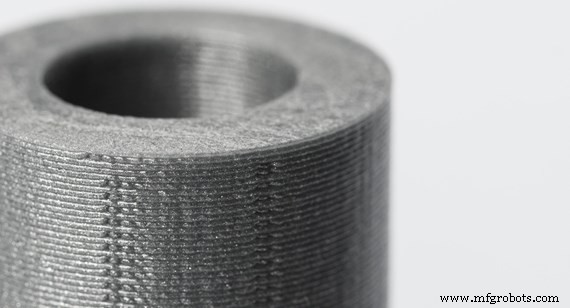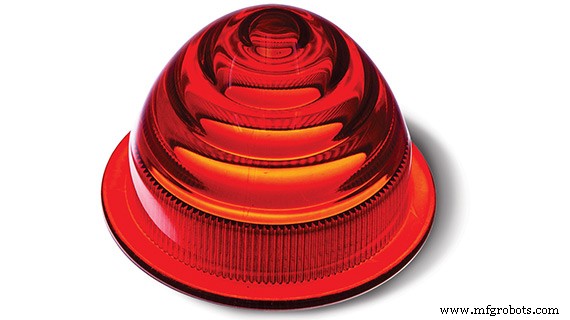SLA vs. FDM:Vergleich gängiger 3D-Drucktechnologien
Die additive Fertigung und insbesondere der moderne 3D-Druck haben seit ihrer ursprünglichen Entwicklung im Jahr 1983 einen langen Weg zurückgelegt. Die heutigen 3D-gedruckten Teile können eine hohe Auflösung und Toleranzen erreichen. Zwei der gebräuchlicheren Techniken sind Stereolithographie (SLA) und Fused Deposition Modeling (FDM). Obwohl beide in den 1980er Jahren entstanden, verwenden sie deutlich unterschiedliche Methoden zur Herstellung von Teilen, und daher bieten die endgültigen Teile jeweils unterschiedliche Vorteile.
 SLA-Teile, die mit MicroFine Gray™-Harz von Protolabs hergestellt werden, erreichen eine mikropräzise Auflösung.
SLA-Teile, die mit MicroFine Gray™-Harz von Protolabs hergestellt werden, erreichen eine mikropräzise Auflösung. Wie funktioniert SLA?
SLA verwendet Photopolymerharze als Rohmaterial für seine Teile. Photopolymere benötigen zum Aushärten intensives ultraviolettes Licht von einem Laser, und das ist die zentrale Idee hinter SLA. Der Bau findet auf einer in Harz getauchten Plattform statt. Ein Laser befindet sich über dem Tank und schmilzt, gelenkt von Präzisionsspiegeln, das flüssige Harz und härtet es aus, um Schicht für Schicht die gewünschte Form des Teils zu erreichen. Die Stützstrukturen sind die ersten Schichten, die erstellt werden und sicherstellen, dass das Teil sicher an der Plattform befestigt und angemessen gestützt wird. Bei jedem Durchgang bricht eine Recoater-Klinge die Oberflächenspannung des Harzes über dem Teil. Das Teil wird dann von unten nach oben aufgebaut.
Wie funktioniert FDM?
FDM, eine der frühesten Formen des 3D-Drucks, wurde von einem der Gründer von Stratasys, Scott Crump, erfunden. Das Konzept ist einfach – es ähnelt stark der Verwendung einer Heißklebepistole. Ein thermoplastisches Filament oder eine Kunststoffspule wird bis zum Schmelzpunkt erhitzt. Der heiße, flüssige Kunststoff tritt durch eine Düse aus, um eine dünne, einzelne Schicht entlang der X- und Y-Achse auf der Konstruktionsplattform zu erzeugen. Die Schicht kühlt schnell ab und härtet aus. Wenn jede Schicht fertiggestellt ist, wird die Plattform abgesenkt und zusätzlicher geschmolzener Kunststoff wird aufgebracht, wodurch das Teil vertikal wächst (entlang der Z-Achse).
Materialeigenschaften von SLA und FDM
| Prozess | So funktioniert es | Stärke | Fertig stellen | Gemeinsame Materialien |
|---|---|---|---|---|
| SLA | Lasergehärtetes Fotopolymer | 2.500–10.000 (psi) 17,2–68,9 (MPa) | Additive Schichten von 0,002-0,006 Zoll (0,051-0,152 mm) typisch | Thermoplastähnliche Photopolymere ähnlich ABS, PC und PP |
| FDM | Verschmolzene Extrusionen | 5.200–9.800 (psi) 35,9–67,6 (MPa) | Additive Schichten von 0,005-0,013 Zoll (0,127-0,330 mm) typisch | ABS, PC, PC/ABS, PPSU, PEEK, ULTEM |
 Auf diesem FDM-Teil sind die Schichtlinien sichtbar. Foto:3Dhubs.com
Auf diesem FDM-Teil sind die Schichtlinien sichtbar. Foto:3Dhubs.com Neither of these techniques creates parts as strong as ones that are injection molded, for example, but they are suitable for rapid prototyping. SLA’s thin layers and strong bonding between the layers makes its parts smoother, with minimal striations along the Z axis, the direction of the build.
SLA Considerations
If details and surface smoothness are important for your part, SLA handily beats FDM. In part, because of its roots in laser technology, SLA parts can offer incredibly fine detail, yet pricing is competitive. Also, the SLA ultraviolet light curing process avoids FDM’s issues caused by heat compressing previously drawn layers. Equally important, SLA offers many additional finishing options, such as dyeing and texturing.
With SLA, there are three resolution levels from which to choose, ranging from 0.004 in. (0.1016mm) to 0.001 in. (0.0254mm) for layer thickness. Choosing one over the other not only affects part quality, but manufacturing time, too. Minimum feature size can be as small as 0.0025 in. (0.0635mm) on the XY plane and 0.008 in. (0.2032mm) on the Z axis.
One important issue with SLA parts is their sensitivity to light. As photopolymers, they can degrade from exposure to UV rays, such as sunlight. Adding a protective coating can slow this process.
MicroFine™ is an exclusive Protolabs material available in gray and green. This micro-resolution, ABS-like material can print layers that are extremely thin:just 0.001 in. (0.0254mm). That kind of precision is a prerequisite for building parts with many small feature details and is regularly used for small and highly accurate medical components.
FDM Considerations
FDM uses engineering-grade materials (see chart above) and offers a range of color options. With some FDM printers, parts can be as large as 427 in. x 153 in. x 172 in. (10,845.8mm x 3,886.2mm x 4,368.8mm). Essentially it depends on the size of the build space. Also, FDM parts are moderately priced, making it ideal for hobbyists, dental offices, and classrooms.
FDM’s tolerance is dependent on how the machine is set up, but can be as small as +/-0.0035 in. (+/-0.0015mm). Layer thickness varies based on the material you’re using, and some printers can print as thin as 0.001 in. (0.0254mm), although this would lead to long print times and may not be possible with larger parts.
Because temperature affects the core material, FDM parts are subject to rippled exterior edges caused as new layers are dropped atop previous layers. These Z-axis issues also cause weakness in the build. So, a part’s strength is entirely dependent on the direction in which it was built.
FDM does not do well with wide, flat areas, and has difficulties printing sharp corners, so adding fillets to your design makes sense. For all these reasons, prototyping with FDM works well when accuracy and surface finish aren't critical.
Although FDM gets the check for cost, SLA is quite competitive, especially for cosmetic prototypes with intricate designs. It’s also a go-to process to create forms for injection molding and casting.
When to Use SLA and FDM
With all of these considerations in mind, here is a list of when to use either method.
Use SLA :
- For rapid, complex prototyping
- When precision and a smooth surface finish is important
- When high resolution, fine detail, and accuracy is necessary
- For creating molds for casting to facilitate mass production
- When strength and durability of the model is not crucial (models made from resin may suffer when exposed to the sun for long periods)
Use FDM :
- For prototyping
- When a selection of colors is needed
- For low-cost models
- When precision and surface finish aren’t crucial
- For hobbyist and maker projects

SLA produced this clear, red taillight with a smooth finish and custom post-production painting.
For additional help, feel free to contact a Protolabs applications engineer at 877-479-3680 or [email protected]. To get your next design project started today, simply upload a 3D CAD model for an interactive quote within hours.
Industrietechnik
- 5 gängige Mythen über den 3D-Druck
- FDM-3D-Druck:Vergleich von ASA-, PETG- und PC-Filamenten
- Aufräumung von 9 verbreiteten Mythen über den 3D-Druck
- FDM-3D-Druck:Wo stehen wir heute?
- Vergleich von 3D-Technologien:SLA vs. FDM
- Stereolithographie (SLA) 3D-Druckdesign-Tipps
- MJF vs. SLS:3D-Drucktechnologien im Vergleich
- FDM-3D-Druck:Desktop vs. Industriell
- 3D-Drucktechnologien (Teil 2)
- Sandguss mit 3D-Drucktechnologien



